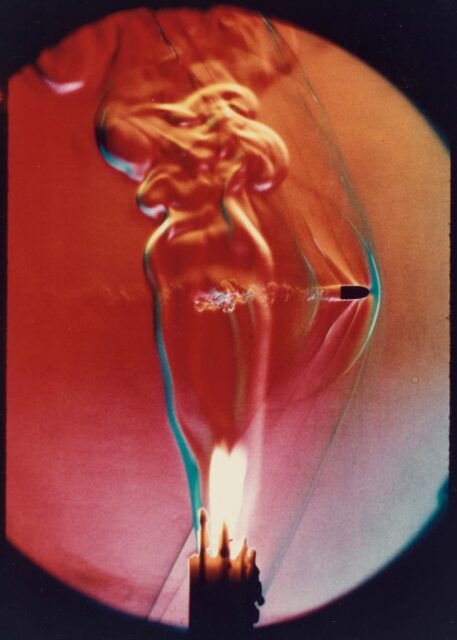Harold Edgerton (American, 1903-1990)
Bullet through Candle Flame
Dye Transfer Print
20 x 16 in.
Gift of John Andrew MacMahon ’95
There’s something about this piece that makes me want to reach out and touch it. Of course, if I did in real life, I would not only burn my hand from the candle, but also lose a finger from the bullet. But there’s something about this rich billow of heat, the liquid-like bubble oozing from the flame, the ripples from the bullet creasing like fabric that feel so luxurious and tangible. From far away, such vivid complexity could not be seen; thanks to science and one of its important artists, we can zoom in to this detailed, ethereal level.
Harold Edgerton’s Bullet through Candle Flame comes from the series, “Ten Dye Transfer Photographs.” Edgerton, a leading scientist and electrical engineer from Fremont, Nebraska, blurred the lines between science and art in the mid-1900s by taking knowledge from physics and engineering and applying it to visual mediums. By working with a stroboscope, a device that causes motion to be perceived as static images due to rapid flashes of light, Edgerton created a technique of high-speed flash photography. He was able to, with the intense bursts of light and an open shutter, photograph very specific moments in time, like spilling milk and popping balloons. In Bullet through Candle Flame, Edgerton’s inventions allowed him to capture a small bullet in the exact moment it punctured a flame. Though the year of this piece is unknown and the quality a bit fuzzy, this photographic technique retains its impressiveness.
There is much to see in this zoomed-in, scientific marvel of an artwork. The bright flame and tiny bullet attract the eye, beckoning viewers in for a second glance. The rich magenta background has a velvety feel to it; the pink bunches up and folds where the bullet pierces it, like fabric. At the same time, the bullet leaves a bubbly trail, as if swimming through liquid. The vapor emitted from the candle flame appears luxurious, like a stream of syrup, tinged with a vibrant blue. The circular view of the flame and bullet has an outer-space-like, atmospheric feel. It’s safe to say that I’m absolutely mesmerized by this photograph.
After spending much time simply staring at the bright colors and ripples of this photo, I began to think about the nature and connotations of science and art. Typically seen as opposites, science and art tend to be separated into distinct and exclusive spheres. Science is concrete, art is abstract. Science deals with raw numbers and solid facts, art focuses on the imagination and creativity. Yet both aim to single out the truths of the world and shed light on reality, whether directly or indirectly. With this photograph, and many others like it, Edgerton combines the technical nature of science with the aesthetic value of art to create awe-inspiring visual images of a beautiful reality. In this way, can science be art? Can art be science? Are these two fields a lot more similar than we consider them to be?
How we view science and art may affect how we interpret this piece. For example, the logical, left-brained side of me is impressed by the photographic technique and marvels how such a shot was even taken, how this could possibly be what the natural world looks like so close up. The artist in me has fallen for the richness of color, the hint of aqua blue, and the tangible texture within the photo. Whether we approach Bullet through a Candle Flame with a scientific lens or an artistic eye, this hypnotic, incredible invention can appease the inner curiosity and creativity in all of us. Because to me, science is art, and art is science. Thanks to Harold Edgerton, this connection has become so much clearer.
– Gaby Sanclimenti ’25
“Harold Edgerton.” Lemelson-MIT, Massachusetts Institute of Technology,https://lemelson.mit.edu/resources/harold-edgerton.

